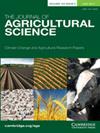秋、春、序贯除草剂对冬小麦多重抗除草剂的防治
IF 1.7
4区 农林科学
Q2 AGRICULTURE, MULTIDISCIPLINARY
引用次数: 0
摘要
在安大略省的环境条件下,秋、春或依次[秋后(fb)春]施用吡磺唑/溴苯醚、氟氧吡啶/甲基氟氧吡啶+甲基氟氧吡啶EHE和氯吡唑啉控制冬小麦中多重抗除草剂(MHR)加拿大fleabane的有效性信息有限。在2020年秋季和2021年秋季启动了3个田间试验,共6个立地年,以评估秋季和春季施用除草剂及其顺序施用对安大略省冬小麦MHR Canada fleabane的控制效果。在春季施用(WAB)后8周,分别在秋季、春季或顺序控制的MHR Canada fleabane 83、99和100%中施用吡唑啉/溴腈;弹簧和顺序应用程序比秋季应用程序提供更好的控制。氟氯昔韦/氟氯昔芬+ MCPA和氯吡唑啉分别在秋季、春季或顺序控制MHR加拿大fleabab97至100%和99至100%,分别为8 WAB。基于正交对比,春季和连续施用除草剂比秋季施用效果更好(8 WAB)。在本研究中,MHR加拿大fleabane干扰使冬小麦产量降低27%。基于正交对比,减少MHR加拿大fleabane对秋季施用的干扰使冬小麦产量比推迟到春季施用时高出17%。虽然用氯吡酯有效地控制了MHR加拿大fleabane,但冬小麦产量较低,可能是由于作物伤害;这一观察结果将在未来的研究中进一步探索。本研究结果表明,吡磺胺/溴苯醚和氟氧吡啶/氟氧吡啶+ MCPA秋季施用可有效防治MHR Canada fleabane,最大限度地减少杂草干扰造成的冬小麦产量损失。本文章由计算机程序翻译,如有差异,请以英文原文为准。
Control of Multiple-Herbicide-Resistant Canada Fleabane With Fall, Spring, and Sequential Herbicide Applications in Winter Wheat
Limited information exists on the efficacy of pyrasulfotole/bromoxynil, fluroxypyr/halauxifen-methyl + MCPA EHE, and clopyralid applied in the fall, spring, or sequentially [fall followed by (fb) spring] for the control of multiple-herbicide-resistant (MHR) Canada fleabane in winter wheat under Ontario environmental conditions. Three field experiments were initiated in the autumn of 2020 and 2021 for a total of 6 site-years to evaluate fall- and spring-applied herbicides and their sequential applications for the control of MHR Canada fleabane in winter wheat in Ontario. Pyrasulfotole/bromoxynil applied in the fall, spring, or sequentially controlled MHR Canada fleabane 83, 99, and 100%, respectively at 8 weeks after the spring application (WAB); the spring and sequential applications provided better control than the fall application. Fluroxypyr/halauxifen + MCPA and clopyralid applied in the fall, spring, or sequentially controlled MHR Canada fleabane 97 to 100% and 99 to 100%, respectively at 8 WAB. Based on orthogonal contrasts the spring and sequential herbicide applications provided greater control than the fall application (8 WAB). MHR Canada fleabane interference reduced winter wheat yield up to 27% in this study. Based on orthogonal contrasts reduced MHR Canada fleabane interference with the fall application resulted in 17% higher winter wheat yield than when herbicide application was delayed to the spring. Although MHR Canada fleabane was controlled very effectively with clopyralid winter wheat yield was lower, presumably due to crop injury; this observation will have to be explored further in future research. Results from this study indicate that pyrasulfotole/bromoxynil and fluroxypyr/halauxifen + MCPA applied in the fall can be used to effectively control MHR Canada fleabane and minimize winter wheat yield loss due to weed interference.
求助全文
通过发布文献求助,成功后即可免费获取论文全文。
去求助
来源期刊

Journal of Agricultural Science
农林科学-农业综合
CiteScore
2.80
自引率
5.00%
发文量
68
审稿时长
1.4 months
期刊介绍:
The Journal of Agricultural Science publishes papers concerned with the advance of agriculture and the use of land resources throughout the world. It publishes original scientific work related to strategic and applied studies in all aspects of agricultural science and exploited species, as well as reviews of scientific topics of current agricultural relevance. Specific topics of interest include (but are not confined to): all aspects of crop and animal physiology, modelling of crop and animal systems, the scientific underpinning of agronomy and husbandry, animal welfare and behaviour, soil science, plant and animal product quality, plant and animal nutrition, engineering solutions, decision support systems, land use, environmental impacts of agriculture and forestry, impacts of climate change, rural biodiversity, experimental design and statistical analysis, and the application of new analytical and study methods (including genetic diversity and molecular biology approaches). The journal also publishes book reviews and letters. Occasional themed issues are published which have recently included centenary reviews, wheat papers and modelling animal systems.
 求助内容:
求助内容: 应助结果提醒方式:
应助结果提醒方式:


